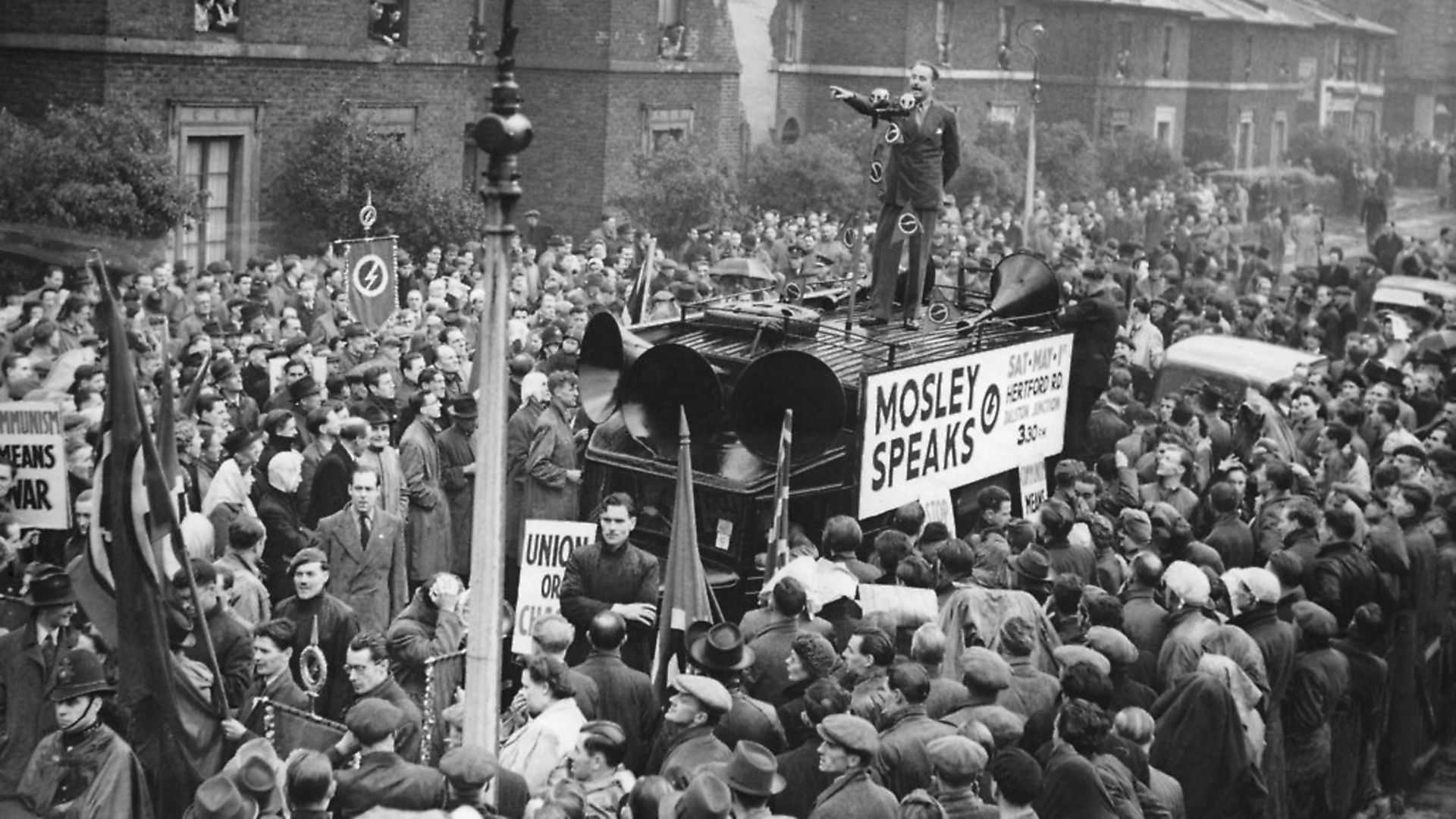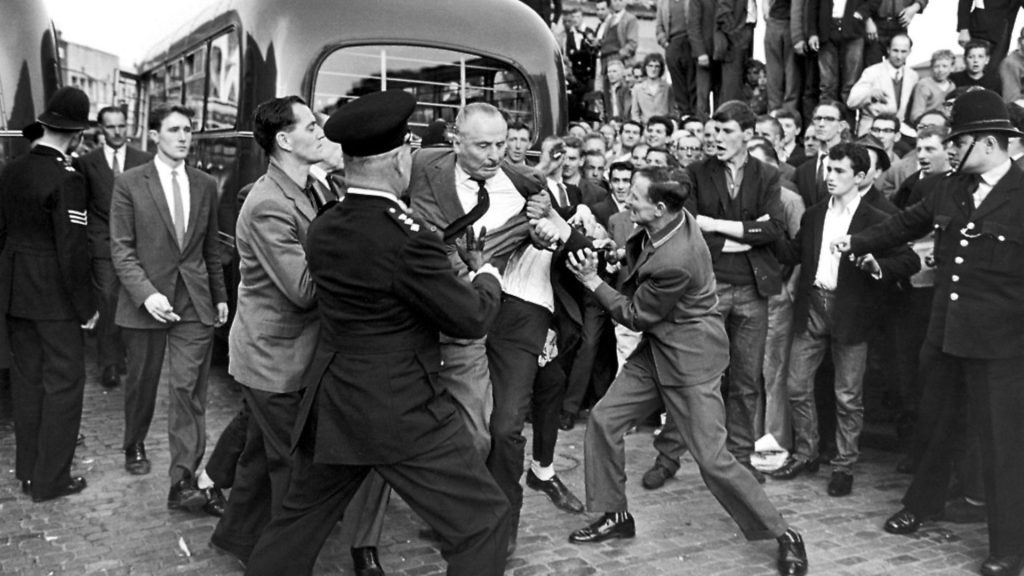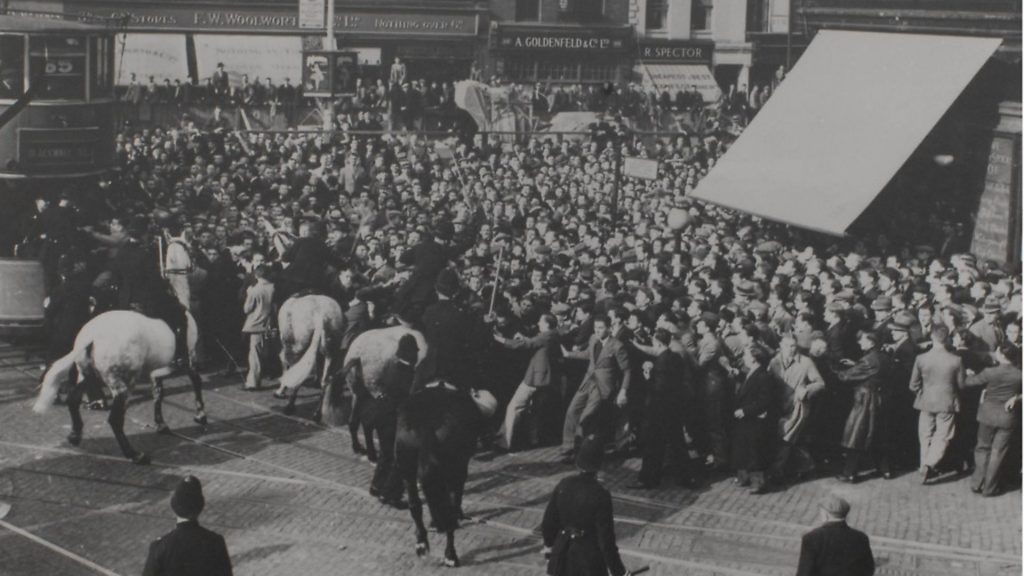
The battle to rid Britain’s streets of fascists did not end with the Second World War. PATRICK SAWER reports on a little-known chapter of UK history, when a group of Jewish war veterans returning home had to continue the fight afresh.

Arriving home from the war exhausted and grateful to be alive, Morris Beckman was greeted by his father with a grim warning.
“The bastards are back,” Beckman Snr. told his son, a Merchant Navy radio officer who had twice survived his ship being torpedoed. As a young Jewish man growing up in London in the 1930s, Morris had seen ‘the bastards’ first hand, as they staged mass rallies to hear Oswald Mosley speak, harangued his fellow Jews on the street and plotted the rise of the ‘master race’.
Having spent the war fighting fascism and Nazism overseas he was in no mood to watch it make a comeback now, on British soil.
Together with a small band of mostly Jewish ex-serviceman, Beckman Jnr. became determined to confront the post-war revival of British fascism with all the means at his disposal. And if that meant physical force so be it.

In a sign that they were deadly serious, Beckman and his comrades perfected something they liked to call the ‘flying wedge’.
This involved forming themselves into a phalanx and physically bludgeoning their way through crowds attending meetings of the British Union of Fascists (BUF) to disrupt the speeches.
Neither were they shy of doling out rough justice to fascist newspaper sellers and street corner demagogues, including the now ageing Mosley.
With the far right and anti-Semitism once again on the rise across Britain, continental Europe and the United States, it is worth examining the unashamedly confrontational activities of Beckman and this now largely forgotten band of former servicemen and the tightly organised unit they called the 43 Group.
The grouping was founded in early 1946 by Beckman, who had taken part in the Battle of the Atlantic and the Allied invasion of Sicily; Alec Carson, an ex-Hurricane fighter pilot; Gerry Flamberg, a middleweight boxing champion who won the Military Medal at Arnhem; Alec Black, a veteran of the D-Day landings; and Len Sherman, a martial arts expert and member of the Welsh Guards, in response to what they regarded as the very real threat of a fascist resurgence in Britain.
It was no idle fear. Surprising as it may seem now, within months of the end of the war no fewer than 14 fascist groups and at least three bookshops operated across London, with newspapers such as Britain Awake and The Patriot openly sold on street corners.
Worse still, fascists had once again begun staging intimidating outdoor rallies in the heart of the Jewish East End, as they had done a decade earlier before being driven out by events such as the 1936 Battle of Cable Street.
British fascist activists interned during the war had begun to regroup, while captured Nazi soldiers released from PoW camps fed into what was a rebirth of the far-right.
The 43 Group were under no illusions. After risking their lives fighting the Nazi regime that had attempted to wipe out Europe’s Jews, Beckman and his comrades knew only too what unchecked fascism could inflict on their community.
And, having grown up during the first incarnation of Mosley and his blackshirts in the pre-war 1930s, they understood more than most that fascism wasn’t confined to mainland Europe.
Jules Konopinski, a former commando who had lost nine uncles and aunts in the Holocaust before joining the 43 Group, later recalled: “Openly in the streets you had public meetings shouting out the same antagonism and the same filth as before the war and now even worse – they were saying the gas chambers weren’t enough.”
The group’s members had little compunction about using boots and fists to make sure a new generation of fascists were physically driven off the streets and prevented from organising and broadening their support.
The launch pad for their activities came in February 1946, when, barely a year after the war’s end and on their way to a pub in Hampstead, Beckman, Carson, Flamberg, and Sherman had spotted a rally of the British League of Ex-Servicemen and Women, the organisation led by Jeffrey Hamm, who had been interned during the war and was now seeking to rebuild Oswald Mosley’s fascist movement.
In a spontaneous act, Sherman, pretending to buy a copy of Britain Awake, knocked two fascists unconscious by banging their heads together. For his part Flamberg, who would later go on to run a chain of jewellery shops and set up the Brunswick Boys Club, inaugurated by Prince Philip, toppled the stage and knocked Hamm over.
Shortly after, at a meeting at Maccabi House, a Jewish sports club in Hampstead, their action was backed by a gathering of 38 ex-servicemen and five women, the majority of them Jewish.
Black proposed setting up an organisation to carry the fight to the fascists and anti-Semites, warning that it could lead to physical injury and possibly prison for those who took part. Apparently not a single person left the meeting.
The organisation became known as the 43 Group, after the number of people in the room, though within two months its ranks had swelled to more than 300.
Among the new recruits was a young man called Vidal Sassoon, who, as a world famous hairdresser, would go on to become one of the trailblazers of swinging London 20 years later.
At the age of 17 he threw himself into the group’s activities with youthful alacrity and determination.
In an interview before his death in 2012, Sassoon told the Iranian Jewish Chronicle: “Most of my friends joined the 43 Group and there were quite a few hundred of us.
“Truly the fascists were smashed in the streets and yes, you were scared at times because it was scary. But after we saw the pictures that came out and the whole story of the Holocaust, there was actually no way we could allow fascists to run through the streets.
“We were absolutely not going to allow what happened pre-war when Jews were just beat up indiscriminately in the streets. It worked beautifully because of mainly the tough Jewish characters that were in the British armed forces during the war. But also there were quite a few gentiles who had seen the camps, the horror of Europe and fought with us.”
Between 1946 and 1947 this determined group of former commandos, Royal Marines and other ex-servicemen – men like Tommy Gould, a Royal Navy petty officer who was awarded the Victoria Cross for removing a bomb from the deck of his submarine in 1942 – led younger members in breaking up an estimated 15 fascist meetings a week.
With London black cab drivers providing intelligence on where Mosley’s followers were gathering, the group’s members would also protect Jewish shopkeepers targeted by the fascists.
Lawyers, doctors and office clerks, often women, were recruited to provide back up and administrative support for the group, which also infiltrated fascist organisations.
The confrontations became increasingly violent. Far-right thugs attempted to bomb Flamberg’s home, while two 43 Group members beat a young fascist unconscious after he rampaged through Stamford Hill slashing people’s faces with razor blades stitched into his flat cap.
Skirmishes between fascists and anti-fascists came to a head on Sunday June 1, 1947, in Dalston’s Ridley Road, then an epicentre of the Jewish community and long a favourite meeting place for Mosley’s British Union of Fascists.
The 43 Group prepared for the ‘Battle for Ridley Road’ with characteristically military precision. Members armed with maps of the surrounding streets sprung ambushes on the fascists, who vastly outnumbered them.
Beckman later recalled: “A young fascist about 18 years of age appeared in front of me and called me a ‘F**king Jew bastard’, catching my left thigh with a nearly well-aimed kick. I hit his nose square on and it spurted blood… I kicked his backside as hard as I could and he staggered off.
“A hard blow landed smack on my right ear and completely unbalanced me. For a moment, I was dazed, disoriented.
“My assailant was about to close and finish me off when Sam grabbed him around the neck and pulled him to the ground.
“Then Sam jumped on him. The genial, good-humoured Sam said, ‘I’m just breaking the bastard’s ribs so he won’t attend any more meetings’.”
The Battle of Ridley Road and subsequent clashes between anti-fascist militants and members of Mosley’s reinvented Union Movement left the far-right demoralised and dispirited.
In April 1950 the 43 Group – whose tactics had been criticised by mainstream parties and Jewish groups such as the Board of Deputies – disbanded, judging that the immediate threat had passed.
But the urgency of its task would be emphasised in the coming years with the arrival of the Windrush generation and migrants from the Asian subcontinent, who quickly found themselves the target of racist attacks on their homes and in the street, just as the parents, aunts and uncles of Beckman and his comrades had done.
The tradition of confronting fascism from the ground up, represented with such powerful effect by these men and women – whose story is told by historian Daniel Sonabend in his forthcoming book The 43 Group and Their Forgotten Battle for Post War Britain – was reawakened years later with the rise of the National Front, culminating on August 13, 1977, in what became known as the Battle of Lewisham.
Here, thousands of anti-fascist activists and trade unionists joined forces with local black and Asian youths in physically driving an NF march off the streets of their south London suburb.
To the disquiet of the mainstream left they attacked the far-right demonstrations, overwhelming them with superior numbers and evading police attempts to keep the rival groups apart. Using local knowledge to duck in and out of side streets – just as the 43 Group had done – they emerged to rain bricks, bottles and smoke bombs onto the heads of the NF marchers, forcing them to scatter and flee the area, dealing a severe blow to the far-right party’s self confidence.
August figures such as Michael Foot, future leader of the Labour Party, condemned the Lewisham protestors, with Foot saying: “You don’t stop the Nazis by throwing bottles or bashing the police. The most ineffective way of fighting the fascists is to behave like them.”
Beckman, and other veterans of the 43 Group, remained unrepentant about the tactics they had pioneered.
Speaking a few years before his death at the age of 94 in May 2015, Beckman said: “One of the lessons of history is you should never let up on the racists and fascists. Racism and fascism should always be attacked. The 43 Group never let up, we took the fascists on relentlessly.”
Patrick Sawer is a senior news reporter at the Daily and Sunday Telegraph









